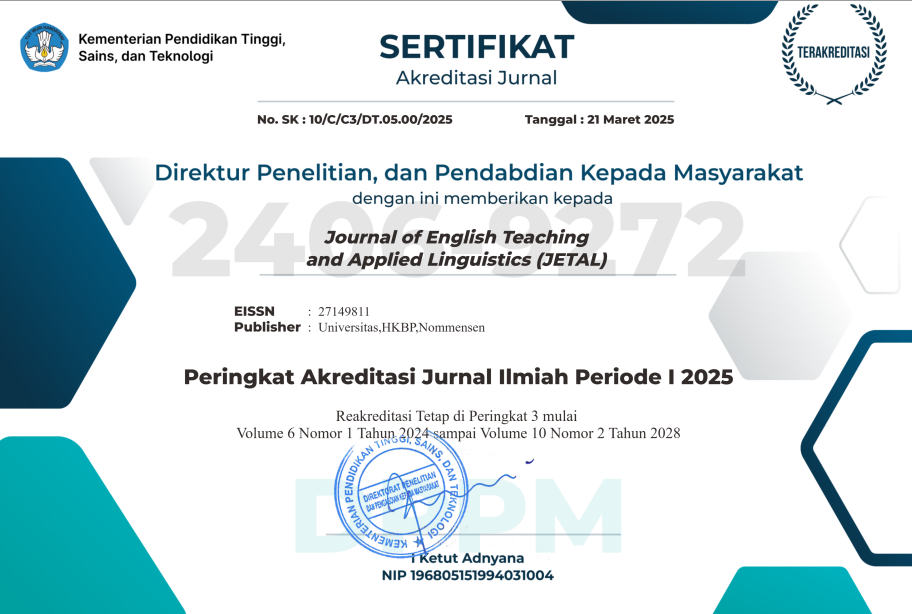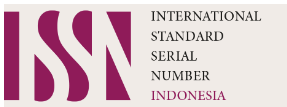IDENTIFICATION OF TRADITIONAL BALINESE FOOD LEXICON IN MENYALI VILLAGE: AN ETHNOLINGUISTIC STUDY
Abstract
For Balinese people, traditional Balinese food is consumed and offered or performed in rituals and Hindu religious activities. Although some traditional Balinese foods have succeeded in becoming world-famous, many traditional Balinese dishes and cooking utensils are now starting to be unknown to the younger generation of Bali, especially the names of traditional foods used for rituals. For this reason, this study aims to identify the lexicons of traditional Balinese food and traditional Balinese cooking utensils. This research is an ethnolinguistic study. This research was conducted in Menyali Village, Sawan District, Buleleng. Data were collected using interviews and observations. Five traditional figures in Menyali Village were selected using the snowballing technique involved in this study. The collected data were analyzed qualitatively using an interactive data analysis model, carried out in three stages: data condensation, data display, and conclusion drawing/verification. This study found 81 lexicons categorized as nouns, consisting of 28 lexicons of traditional Balinese food names, 33 cooking tools, and 20 cooking spices. This study also identified 21 verbs related to the techniques or processes of cooking traditional Balinese food. In addition, this study also identified 28 adjectives related to traditional Balinese food. Thus, this study has successfully identified 130 lexicons related to food and cooking tools for traditional Balinese food. Considering the existence of the Balinese language, which is now starting to be endangered, the list of lexicons can be an essential note in maintaining it.
References
Albanna, H., Alalwan, A. A., & Al-Emran, M. (2022). An integrated model for using social media applications in non-profit organizations. International Journal of Information Management, 63, 102452. https://doi.org/https://doi.org/10.1016/j.ijinfomgt.2021.102452
Ardi, R., Tobing, D. H., Agustina, G. N., Iswahyudi, A. F., & Budiarti, D. (2021). Religious schema and tolerance towards alienated groups in Indonesia. Heliyon, 7(7), e07603. https://doi.org/https://doi.org/10.1016/j.heliyon.2021.e07603
Ariani, R. P., Darmawan, D. P., Bawa Atmaja, N., Anom, M., & Wijaya, S. (2018). Balinese Traditional Culinary Promotes Food Skills and Its Positive Impact on Tourism Vocational School. International Journal Of Life Sciences (IJLS), 2(1), 50–62. https://doi.org/10.29332/ijls.v2n1.107
Artisna, P., Naswa, F., & Rohmah, M. (2022). Respon Generasi Milenial Indonesia di Tengah Masuknya Budaya Asing. Universitas Negeri Surabaya 2022 |, 695, 695–705.
Aslamiyah, W., Herianto, E., & Alqodri, B. (2023). Youth Interest in Korean Culture (K-Pop) and its Impact on Indonesian Nationalism. Jurnal Sosial Ekonomi Dan Humaniora, 9(2), 129–134. https://doi.org/10.29303/jseh.v9i2.345
Baek, T. H., & Yoon, S. (2022). Pride and gratitude: Egoistic versus altruistic appeals in social media advertising. Journal of Business Research, 142, 499–511. https://doi.org/https://doi.org/10.1016/j.jbusres.2021.12.066
Bangsa, B. P., & Sihombing, L. H. (2022). Impact of Japanese Popular Culture to Indonesian younger Generation: Humaniora, 13(3), 241–246. https://doi.org/10.21512/humaniora.v13i3.8131
Bearth, A., Khunnutchanart, K., Gasser, O., & Hasler, N. (2021). The whole beast: Consumers’ perceptions of and willingness-to-eat animal by-products. Food Quality and Preference, 89, 104144. https://doi.org/https://doi.org/10.1016/j.foodqual.2020.104144
Bestari, N. M. P., Suryawan Wiranatha, A., Oka Suryawardani, I. G. A., & Darma Putra, I. N. (2022). Rejuvenating Cultural Tourism Through Gastronomic Creative Tourism in Ubud Bali. Mudra Jurnal Seni Budaya, 37(2), 136–145. https://doi.org/10.31091/mudra.v37i2.1938
Briawan, D., Khomsan, A., Alfiah, E., Nasution, Z., & Putri, P. A. (2023). Preference for and consumption of traditional and fast foods among adolescents in Indonesia. Food Research, 7(4), 211–226. https://doi.org/10.26656/fr.2017.7(4).156
Budasi, I. G., Ana, I. K. T. A., Suwindia, I. G., & Sedana, I. M. (2023). Male versus Female Understanding of the Endangered Lexicon of Tabuh Rah Ritual. Theory and Practice in Language Studies, 13(11).
Chatti, W., & Majeed, M. T. (2022). Information communication technology (ICT), smart urbanization, and environmental quality: Evidence from a panel of developing and developed economies. Journal of Cleaner Production, 366, 132925. https://doi.org/https://doi.org/10.1016/j.jclepro.2022.132925
Cristiana, D., & Yunaningsih, A. (2020). Edukasi Alat Dapur Tradisional Untuk Pelestarian Warisan Budaya. Altasia Jurnal Pariwisata Indonesia; Vol 2 No 3 (2020): Jurnal ALTASIA (Agustus). https://doi.org/10.37253/altasia.v2i3.843
Dayini, N. W. S. M., Uyeni, N. W. A., Dinata, I. N. B. S., & Widnyana, I. W. (2022). Pemanfaatan Aplikasi Antar Makanan Dimasa Pandemi Untuk Menunjang Usaha Kuliner Masyarakat Dikalangan Generasi Z Pada Era Society 5.0. Webminar Nasional Pekan Ilmiah Pelajar, 328–341. https://doi.org/10.2207/jjws.91.328
Diatmika, P. P. R., Dwijendra, N. K. A., & Sukawati, T. O. A. A. (2017). Penerapan Konsep Arsitektur Hijau pada Restoran Tradisional Bali. 1304205070, 175–180.
Farizi, F. I., & Mustofa, T. A. (2023). The influence of western culture on the behaviour of senior high school students. Scafolding: Jurnal Pendidikan Islam Dan Multikultural, 5(2), 907–918. https://doi.org/10.2307/2383178
Febrianty, Y., Pitoyo, D., Masri, F. A., Anggreni, M. A., & Abidin, Z. (2023). Peran Kearifan Lokal dalam Membangun Identitas Budaya dan Kebangsaan. El-Hekam, 7(1), 168–181.
Fitriawati, D. M. I., Dewi, I. A. K., Diana, G. A. M., & Winarta, I. B. G. N. (2023). Upaya Melestarikan Tarian Tradisional di Era Modern. Prosiding Pekan Ilmiah Pelajar (PILAR), 3, 78–88.
Flynn, M. A., Veilleux, E., & Stana, A. (2022). A post from the woods: Social media, well-being and our connection to the natural world. Computers in Human Behavior Reports, 5, 100171. https://doi.org/https://doi.org/10.1016/j.chbr.2022.100171
Fraenkel, J. R., Wallen, N. E., & Hyun, H. H. (2014). How to Design and Evaluate Research in Education (9th Ed). McGraw-Hill.
Gill-Wiehl, A., Price, T., & Kammen, D. M. (2021). What’s in a stove? A review of the user preferences in improved stove designs. Energy Research & Social Science, 81, 102281. https://doi.org/https://doi.org/10.1016/j.erss.2021.102281
Jia, B., Li, J., & Ma, J. (2022). Transformation of Fan Culture Under the Influence of Social Media. Proceedings of the 2021 4th International Conference on Humanities Education and Social Sciences (ICHESS 2021), 615(Ichess), 2173–2178. https://doi.org/10.2991/assehr.k.211220.375
Jung, S., & Shim, D. (2013). Social distribution: K-pop fan practices in Indonesia and the ‘Gangnam Style’ phenomenon. International Journal of Cultural Studies, 17(5), 485–501. https://doi.org/10.1177/1367877913505173
Juniari, L. E., & Diantary, N. M. Y. A. (2023). Kegiatan Ngayah Sebagai Jalan Memperkuat Rasa Persaudaraan Umat Hindu di Bali. Jurnal Prodi Teologi Hindu STAHN Mpu Kuturan Singaraja, 3(1), 73–81.
Kross, E., Verduyn, P., Sheppes, G., Costello, C. K., Jonides, J., & Ybarra, O. (2021). Social Media and Well-Being: Pitfalls, Progress, and Next Steps. Trends in Cognitive Sciences, 25(1), 55–66. https://doi.org/https://doi.org/10.1016/j.tics.2020.10.005
Lai, C., & Cai, S. (2023). The nature of social media use and ethnic minorities’ acculturation. International Journal of Intercultural Relations, 96, 101852. https://doi.org/https://doi.org/10.1016/j.ijintrel.2023.101852
Levisen, C. (2015). Scandinavian semantics and the human body: an ethnolinguistic study in diversity and change. Language Sciences, 49, 51–66. https://doi.org/https://doi.org/10.1016/j.langsci.2014.05.004
Li, Y.-M., Wu, J.-D., Hsieh, C.-Y., & Liou, J.-H. (2020). A social fundraising mechanism for charity crowdfunding. Decision Support Systems, 129, 113170. https://doi.org/https://doi.org/10.1016/j.dss.2019.113170
Liu, Y., Cheng, W., & Yin, Y. (2023). Cross cultural Comparative Study on Emotional Analysis of Social Media. Procedia Computer Science, 221, 634–641. https://doi.org/10.1016/j.procs.2023.08.032
Lubis, A. R., Fachrizal, F., & Lubis, M. (2017). The Effect of Social Media to Cultural Homecoming Tradition of Computer Students in Medan. Procedia Computer Science, 124, 423–428. https://doi.org/10.1016/j.procs.2017.12.173
Marsiti, C. I. R., Suriani, N. M., & Sukerti, N. W. (2019). Strategi Pengembangan Makanan Tradisional Berbasis Teknologi Informasi Sebagai Upaya Pelestarian Seni Kuliner Bali. Jurnal IKA, 17(2), 128. https://doi.org/10.23887/ika.v17i2.19844
Miles, B., Huberman, M., & Saldana, J. (2014). Qualitative data analysis: A methods sourcebook. SAGE Pub.
Mulyani, P. A., Sudiartini, N. W., & Sariani, N. L. P. (2020). Perilaku masyarakat kota denpasar dalam mengkonsumsi makanan cepat saji (Fast food). JUMA: Jurnal Ilmu Manajemen, 10(2), 91–103.
Nurova, U. Y. (2021). The emergence and development of Ethnolinguistics. Middle European Scientific Bulletin, 8(5), 91–110. https://doi.org/10.1177/0952695114541864
Nyoman Sunada, I. (2019). Potensi Makanan Tradisional Bali yang Berbasis Masyarakat Sebagai Daya Tarik Wisata di Pasar Umum Gianyar. Jurnal Gastronomi, 7(1), 27–47.
Pitriani, N. R. V. (2020). Tradisi “Ngayah” Sebagai Wadah Komunikasi Masyarakat Hindu Perspektif Pendidikan Humanis-Religius. Jurnal Ilmiah Ilmu Agama Dan Ilmu Sosial Budaya, 15(2), 157–169.
Prastowo, I., Nurusman, A. A., Moro, H. K. E. P., Rizkianti, & Dewi, C. (2023). Diversity of Indonesian offal-based dishes. Journal of Ethnic Foods, 10(1), 15. https://doi.org/10.1186/s42779-023-00181-8
Puspitasari, D., Suryadi, Y., & Widodo, H. (2022). Culture Industry and Japanese Identity in Snack and Drinks Products in Indonesia. Izumi, 11(1), 31–43. https://doi.org/10.14710/izumi.11.1.31-43
Putri, I. A. T. E., & Kesumadewi, P. D. (2017). Traditional Balinese Food Existence and Appealing as The Culinary Tourism at Stars Hotels at Sanur Denpasar Bali. Journal of A Sustainable Global South, 1(1), 3–7.
Rindermann, H., & te Nijenhuis, J. (2012). Intelligence in Bali — A case study on estimating mean IQ for a population using various corrections based on theory and empirical findings. Intelligence, 40(5), 395–400. https://doi.org/https://doi.org/10.1016/j.intell.2012.06.005
Rochwulaningsih, Y., Sulistiyono, S. T., Utama, M. P., Masruroh, N. N., Rukayah, S., Efendy, M., & Gozan, M. (2019). Traditional knowledge system in palung salt-making in Bali Island. Journal of Ethnic Foods, 6(1), 10. https://doi.org/10.1186/s42779-019-0018-2
Sabbagh, M., Gutierrez, L., Lai, R., & Nocella, G. (2023). Consumer Intention towards Buying Edible Beef Offal and the Relevance of Food Neophobia. In Foods (Vol. 12, Issue 12). https://doi.org/10.3390/foods12122340
Setiawati, N. K., Sukarsa, I. K. G., Gandhiadi, G. K., & Kencana, I. P. E. N. (2022). Faktor-Faktor Yang Melatarbelakangi Keputusan Konsumen Menggunakan Jasa Layanan Grabfood Pada Aplikasi Grab Di Kota Denpasar. E-Jurnal Matematika, 11(2), 79. https://doi.org/10.24843/mtk.2022.v11.i02.p364
Suastina, G. A. P. D., Arjita, I. P. D., Adnyana, I. G. A., & Rozikin. (2023). Efek Base Genep Terhadap Total Plate Count dan Most Probable Number Escherichia coli pada Lawar Plek. Intisari Sains Medis, 14(1), 504–512. https://doi.org/10.15562/ism.v14i1.1654
Subandi, F. P. P., Romadlon, F., Nurisusilawati, I., & Chindyana, A. (2022). Sentiment Analysis of Indonesian Interest in Korean Food Based on Naïve Bayes Algorithm. Jurnal Sosioteknologi, 21(3), 337–346. https://doi.org/10.5614/sostek.itbj.2022.21.3.10
Tarini, N. M. A., Susilawathi, N. M., Sudewi, A. A. R., Soejitno, A., Fatmawati, N. N. D., Mayura, I. P. B., Lestari, A. A. W., Suputra, G., Subrata, I. K., Astiti, C. I. S. D., Besung, I. N. K., & Mahardika, G. N. (2022). A large cluster of human infections of Streptococcus suis in Bali, Indonesia. One Health, 14, 100394. https://doi.org/https://doi.org/10.1016/j.onehlt.2022.100394
Torkayesh, A. E., & Torkayesh, S. E. (2021). Evaluation of information and communication technology development in G7 countries: An integrated MCDM approach. Technology in Society, 66, 101670. https://doi.org/https://doi.org/10.1016/j.techsoc.2021.101670
Tsunoda, T. (2001). Language Endangerment (N. J. Smelser & P. B. B. T.-I. E. of the S. & B. S. Baltes (eds.); pp. 8349–8353). Pergamon. https://doi.org/https://doi.org/10.1016/B0-08-043076-7/03046-1
Ulung, A. K. (2023). Turning Ubud Into Unwto’S Prototype for a World Gastronomic Destination Through Gastrodiplomacy. Global: Jurnal Politik Internasional, 25(1), 1–26. https://doi.org/10.7454/global.v25i1.1261
Yani, K. N. H., Budasi, I. G., Ramendra, D. P., Artini, L. P., & Ana, I. K. T. A. (2021). Content and language integrated learning in bilingual education: What can we learn from the previous studies? 6(11), 81116.
Yuniawan, T., Rohman, F., & Zulaeha, I. (2020). Eco-linguistic analysis on flora and fauna lexicons on the motifs of batik Pekalongan, Indonesia. International Journal of Advanced Science and Technology, Vol. 29(5), 6549–6566. http://sersc.org/journals/index.php/IJAST/article

This work is licensed under a Creative Commons Attribution-ShareAlike 4.0 International License.
Authors retain copyright and grant the journal right of first publication with the work simultaneously licensed under a Creative Commons Attribution-ShareAlike 4.0 International License (CC BY-SA 4.0) that allows others to share the work with an acknowledgment of the work's authorship and initial publication in this journal.
Authors are able to enter into separate, additional contractual arrangements for the non-exclusive distribution of the journal's published version of the work (e.g., post it to an institutional repository or publish it in a book), with an acknowledgment of its initial publication in this journal.
Authors are permitted and encouraged to post their work online (e.g., in institutional repositories or on their website) prior to and during the submission process, as it can lead to productive exchanges, as well as earlier and greater citation of published work (See The Effect of Open Access).






